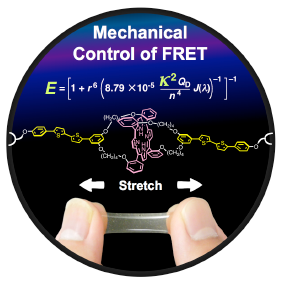Group
有機材料グループ Organic Materials Group
Result H23

K. Sugiyasu et al., Bull. Chem. Soc. Jpn., 2011, 84, 40.
分子運動を制御する方法論の確立は、新しい機能性材料の開発へ繋がると期待されます。我々は、エラストマーフィルム中に、共有結合を介して機能性分子を導入し、フィルムを引き伸ばすことで、分子のコンフォメーション変化に基づく発光特性を制御することに成功しました。
Control over molecular motion is significant for the development of novel molecular materials. We have incorporated a functional molecule in an elastomeric material, and succeeded in controlling its photophysical properties through controlling the molecular conformation by stretching the film.

T. Nakanishi, J. Aimi et al, Angew. Chem. Int. Ed. 2012, 51, 3391-3395. (Highlighted in Nature 2012, 484, 9.)
常温液状有機材料: π共役分子を柔軟性でかつ粘性の低い分子アルキル側鎖により取り囲み、π共役コア(例えば:オリゴフェニレンビニレン:OPV)を隔離・孤立化することで、青色蛍光を示す室温液状の有機材料を創製した。この青色発光液体を溶媒と見立て、発光固体ドーパントを混ぜ込むことで、様々な基板に塗布可能な白色発光液体が得られた。
Isolation of a π-core by attached soft and low viscosity branched-hydrocarbon chains has been employed to synthesize nonvolatile, blue emitting oligo(phenylenevinylene) (OPV) room temperature liquids. The solvent-free formulation of a white light emitting ink, which is applicable on LEDs and various type and shape of substrates, can be prepared by simple blending of the liquid OPV with emissive solid dopants.
